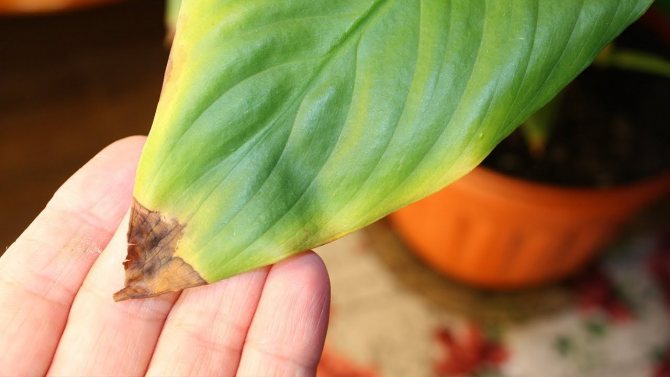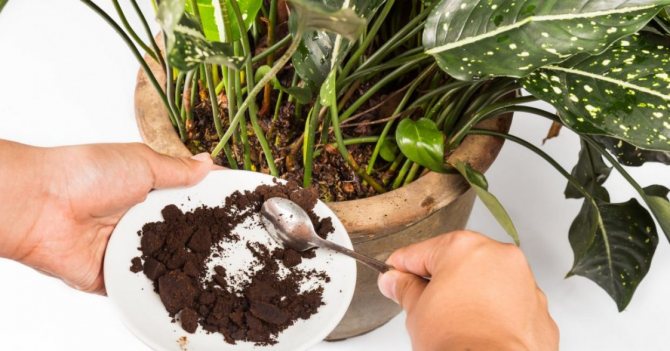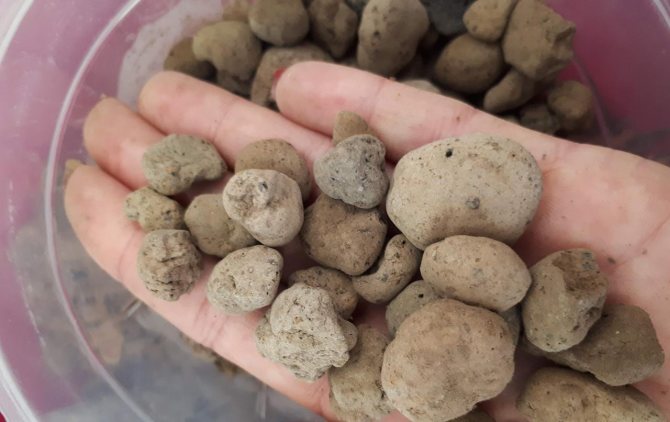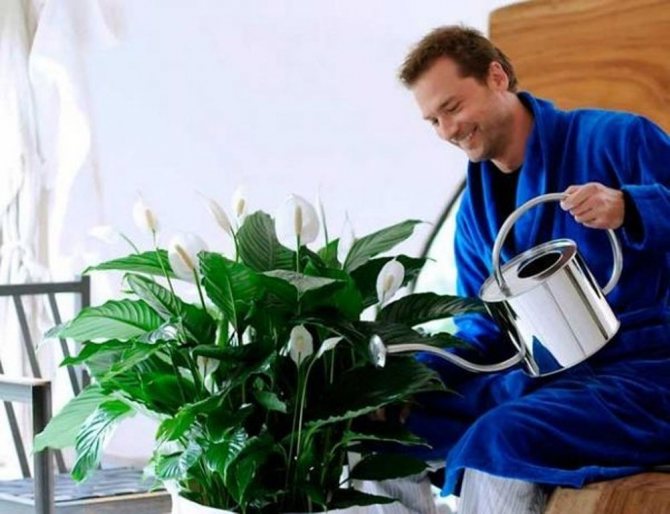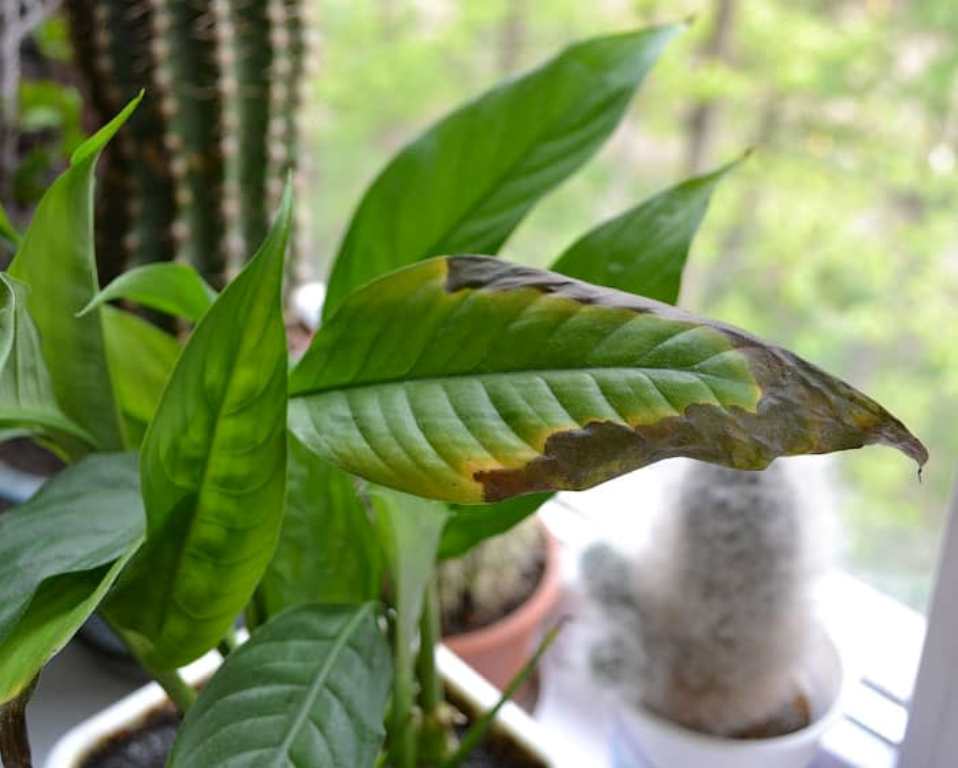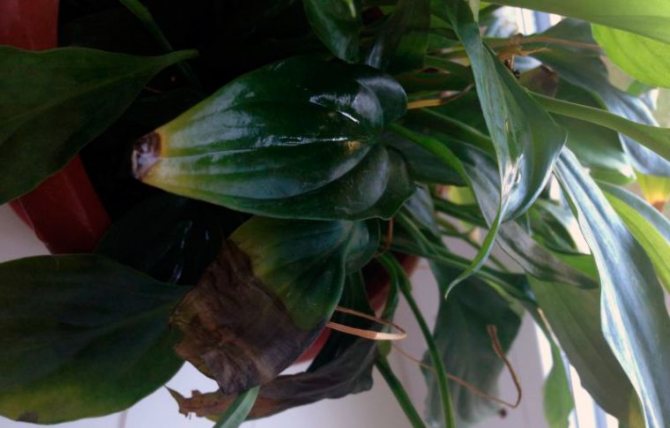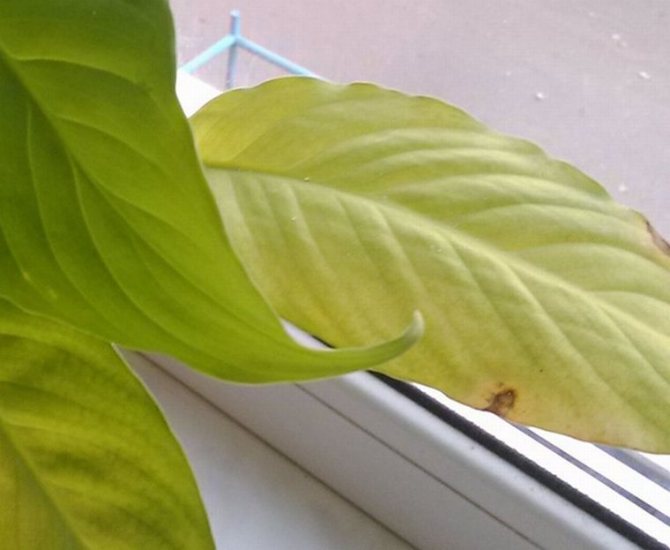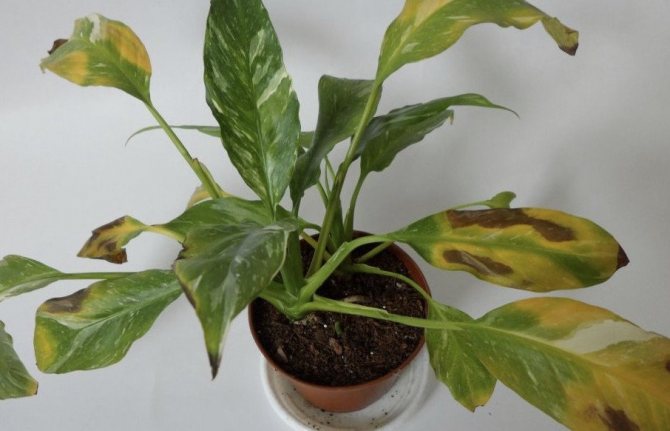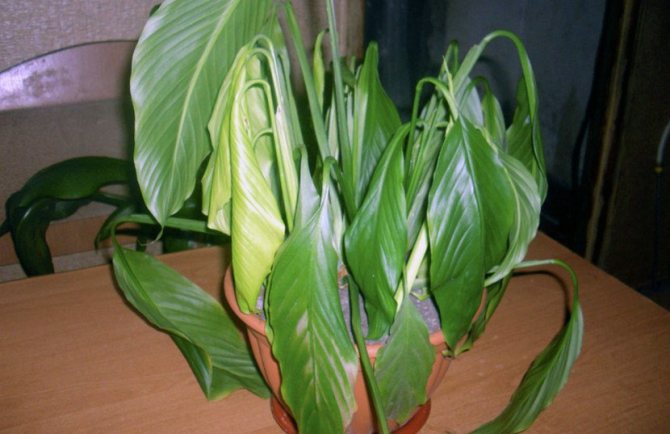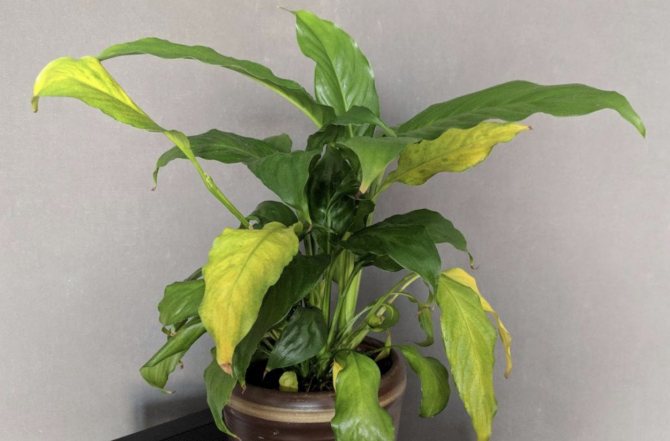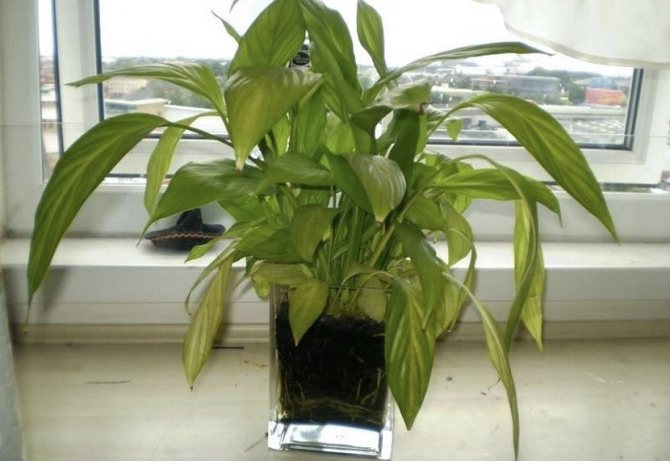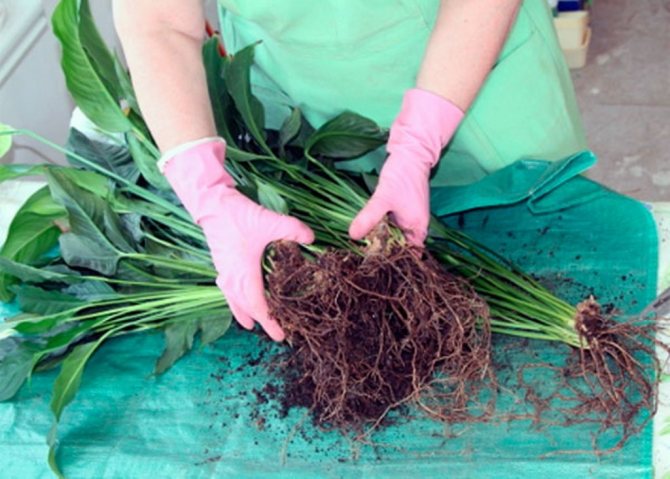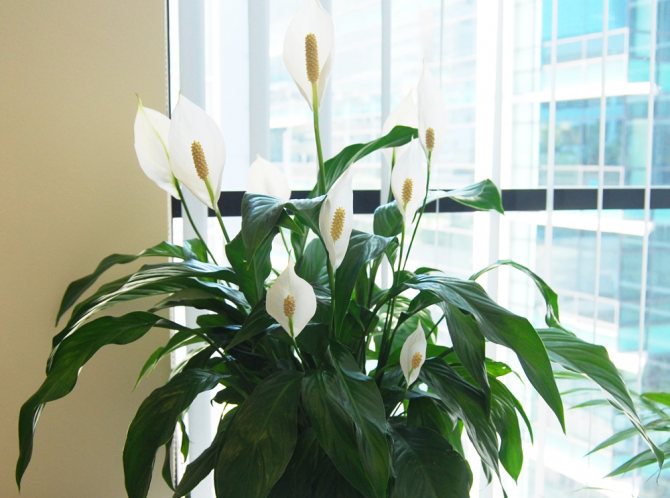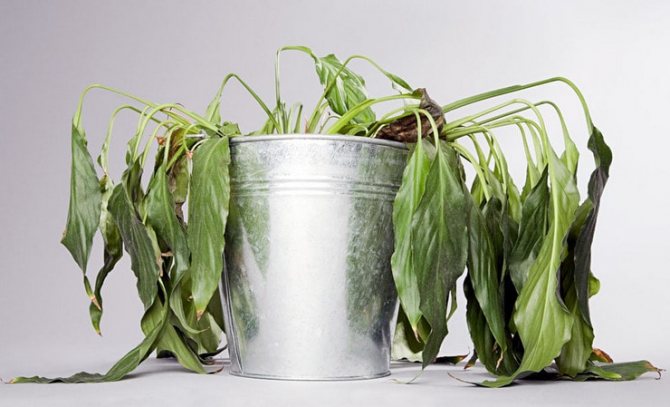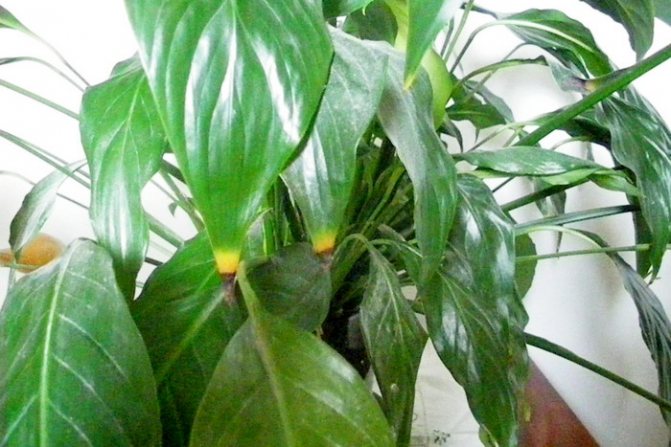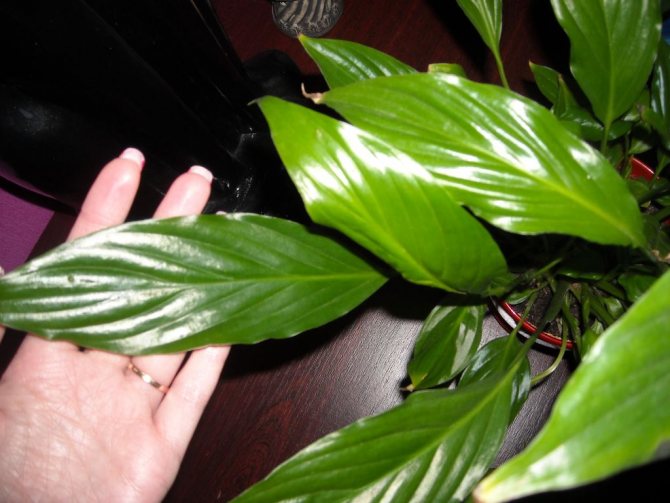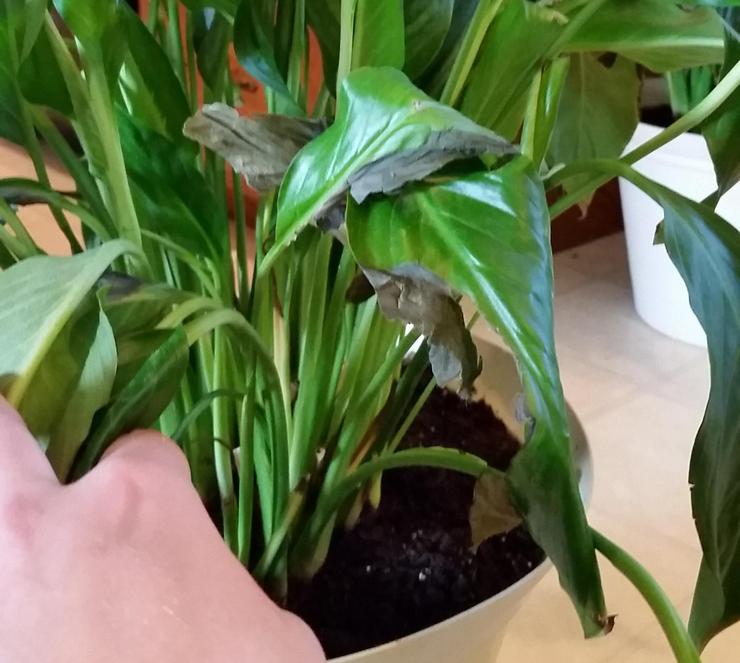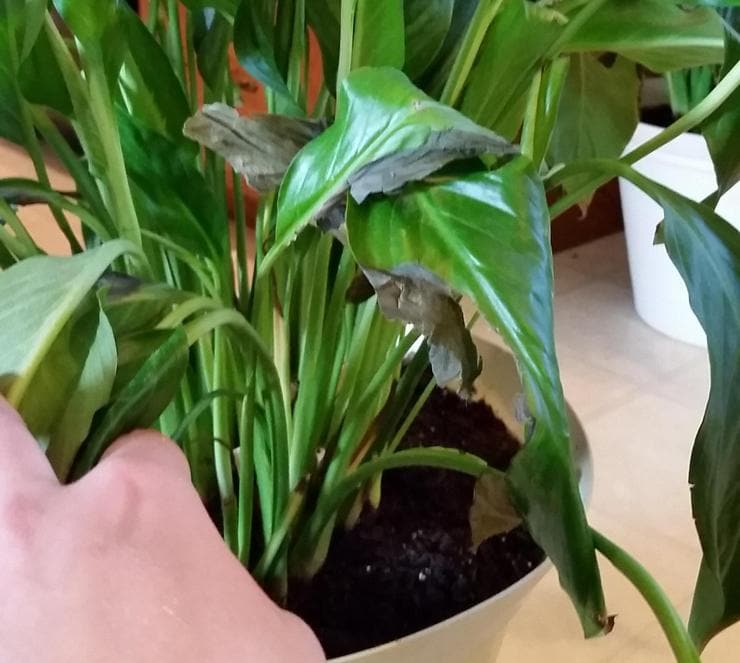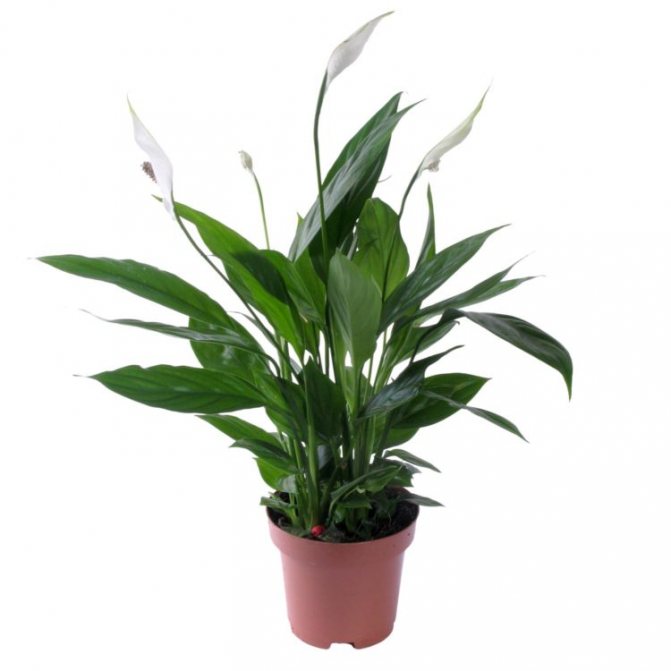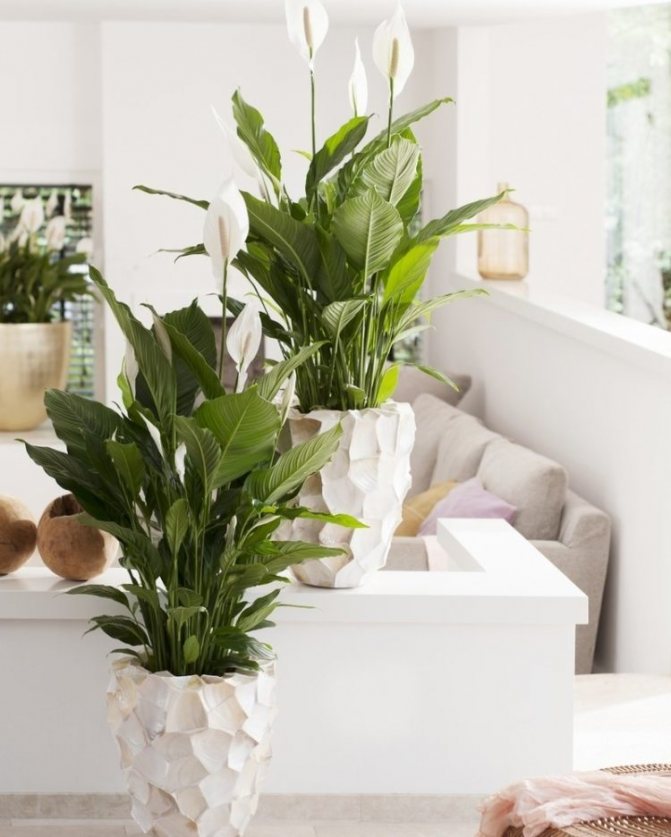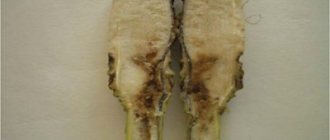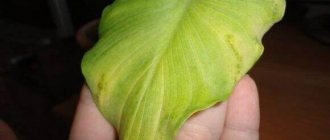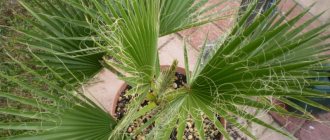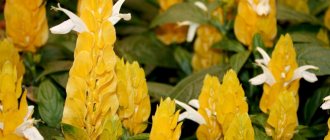The main reasons for yellowing leaves on spathiphyllum, as noted by many growers, are mistakes in caring for the plant.
Spathiphyllum is a very beautiful flower with dark green, almost emerald elliptical leaves. The flower, being a native of tropical forests, has become widespread in Russia. It is often called “female happiness”. For this reason, he is very popular with the fairer sex. According to popular belief, this green handsome man is able to attract female happiness to the house of his mistress. The plant is believed to improve energy in the home, bring well-being and peace. If there is discord in the family, then the leaves of the spathiphyllum dry, it stops blooming and may even die.
Among the wide variety of spathiphyllum species, and there are more than 45 of them, there are varieties named after great composers, such as Vivaldi or Mozart. Large-leaved and tall Euro Gigant look very unusual and beautiful. There are also dwarf plant species such as Petite and Quatro. Their height does not even reach 20 cm.
Usually female happiness blooms at the very end of winter and early spring with white or greenish inflorescences-cobs.
Depletion
Spathiphyllum blooms for a long time, so this process will require many essential nutrients. If the plant is not given special care during flowering, it loses strength, which leads to its depletion.

Signs: yellowing begins from the lower layer of leaves, which spreads quickly and evenly. If you do not provide assistance in a timely manner, all leaf plates on the plant will wither.
Natural causes
The yellowness of the leaves of the spathiphyllum is not always associated with pathology. For example, in an adult flower, the leaves may turn yellow and dry out after a long flowering. So the plant simply restores strength.
Spathiphyllum leaves turn yellow due to the fact that young plants are preparing to bloom. For the formation of a new inflorescence, a large amount of mineral and organic substances is required. The plant gets rid of some of the leaves to support the formation and growth of a new flower.
In these cases, yellowing of the leaves is a completely normal biological phenomenon and should not be a cause for concern.
Caring for "women's happiness" at home is simple and does not require much effort. These flowers are very responsive to care and, if grown correctly, will delight you for a long time.
Diseases and pests


If spathiphyllum is properly cared for, it will rarely get sick. Most often, the plant is affected by the fungus. Spathiphyllum can be exposed to pests or spores from the affected soil or from a nearby plant.
Signs: all leaves of the plant turn yellow; white bloom appears on the lower part of the leaf plate or insects accumulate, which can become carriers of diseases.
When is it natural?


Despite the large number of reasons why a plant can turn yellow, there are also natural ones. An old plant (over 5 years old) can thus get rid of unnecessary foliage.Thus, he produces self-rejuvenation and prepares for the appearance of new leaves. You can wait until they fall off by themselves, or you can cut them off at the base with sharp scissors for aesthetic reasons.
During the dormant period (autumn - winter), the leaves of the spathiphyllum may lighten a little and become soft, but don't be intimidated. With the onset of spring, they will again become rich in color and gain elasticity. Thus, the flower accumulates resources for further flowering.
When exhausted
If the cause of the yellowing of the leaves of the spathiphyllum is exhaustion, it should be transplanted immediately. To do this, it is worth preparing a new pot, which will be slightly larger than the old one. Prepare fresh soil. Remove the plant from the flowerpot, and shake the root system from the old soil, while keeping the small roots. It is also necessary to place a drainage layer in a new pot and pour a little new substrate. Place the plant in the pot and spread the roots. Sprinkle with earth on top, while you should not deepen the growth point. No top dressing should be applied for a month after transplanting. As soon as the yellow leaves that remain on the plant wilted completely, it is necessary to remove them, and then start feeding the soil with fertilizers. Half of the usual dosage will work for you. Gradually, portions of dressings will need to be brought to normal.
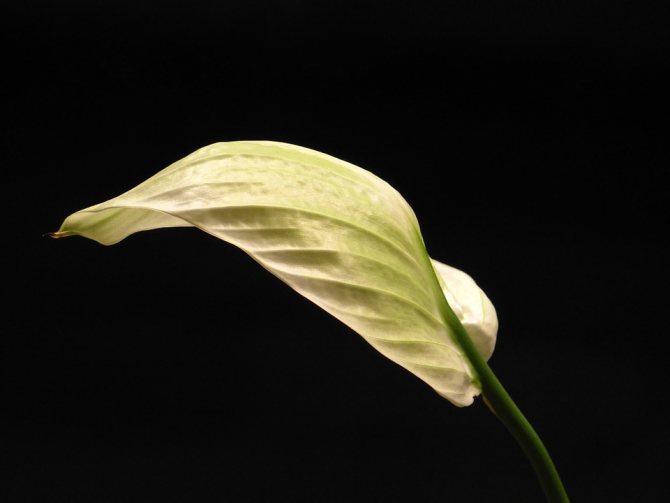

It is important to know that if the transplantation of spathiphyllum is hampered by its strong growth, it is necessary to remove the top layer of the earth (about 4-5 centimeters thick), and then fill up the new soil and not change the feeding regime.
Leaves turn black
The primary reason why spathiphyllum leaves turn black is due to excess moisture. Including too frequent spraying of the flower with water. Again, you should pay attention to the normalization of the watering regime and moisturizing the flower.
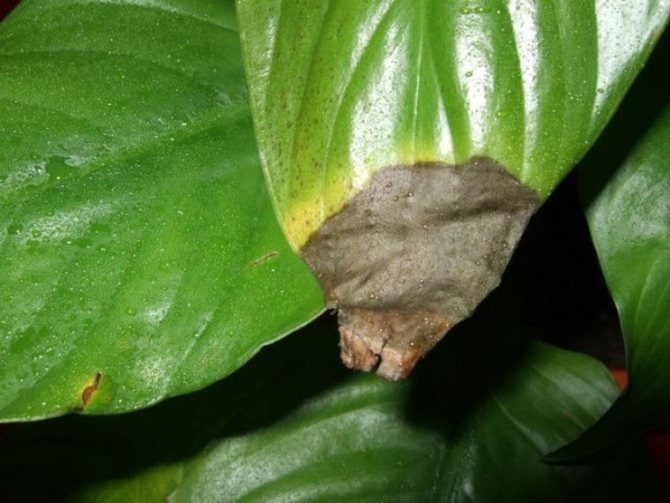

In addition, a common reason why the tips of the leaves turn black in spathiphyllum is a disease of the root system. An improperly arranged drainage system in the container where the flower grows can lead to stagnation of moisture in the root system of the plant. The roots start to rot. Rotten microbes move through the root system to the leaves and infect them. In this case, the blackened flower must be removed from the flowerpots, removed the damaged roots, treated with a special compound that stimulates the growth of a new root system, and transplanted into another substrate.
Sometimes spathiphyllum leaves turn black from an imbalance in the nutrition of the plant. From a lack of, for example, nitrogen in the soil, the plant "female happiness" can wither and turn black. It is worth paying attention to the complex fertilization of the flower during the period of its active growth.
The leaves of the spathiphyllum turn black and from an excess of feeding. It is undesirable to introduce strong fertilizers into the soil to the plant unnecessarily.
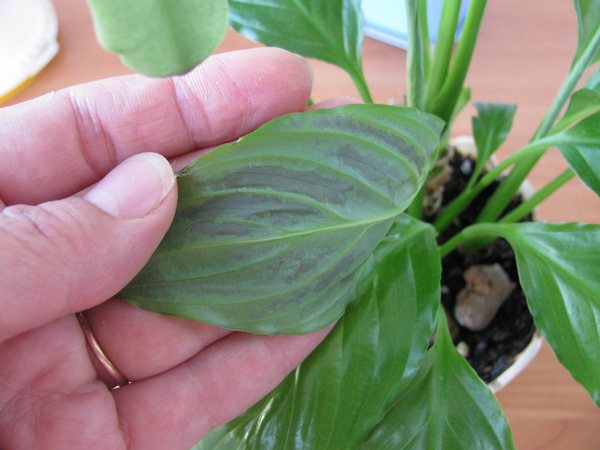

Low humidity
Leaves that have completely turned yellow must be removed. There are several ways to fix the dry indoor air problem:
- cover batteries with a thick blanket or damp towel;
- place a container filled with water next to the plant;
- put a tray with peat, expanded clay or pieces of wet sphagnum on the windowsill; if necessary, add water to the tray;
- regularly spray the air around the spathiphyllum from a spray bottle;
- you can use a humidifier.
Preventive measures
Prevention includes the simplest manipulations:
- maintaining a sufficient level of humidity;
- finding the plant only under diffused sunlight;
- the product of correct watering and dressing.
At the first signs of pests or diseases, the plant must be immediately processed and planted in new soil.
Before we start growing spathiphyllums at home, do not be afraid of the above problems.This plant is extremely unpretentious and therefore is able to actively grow and even bloom in the most unsuitable conditions for this. All that is required from the florist is attention to detail and a little patience.
When damaged by pests or diseases
At an early stage of damage to the plant by pests, the bush should be washed with an infusion of wood ash or onion husks. Also, for spraying, you can use decoctions of strong-smelling or poisonous plants: valerian, tansy, celandine and mint.
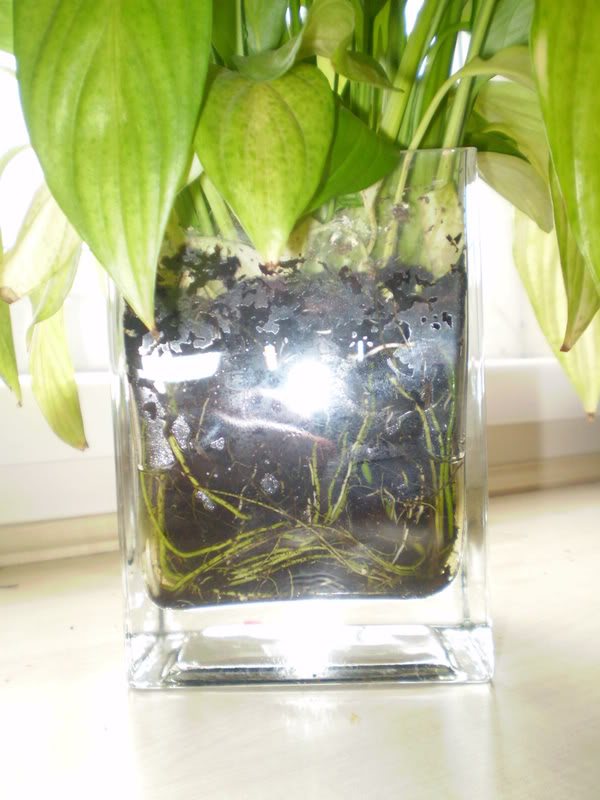

Decoction recipe:
- cut raw materials;
- place in an enamel bowl;
- pour boiling water;
- place on a quiet fire, do not let it boil;
- remove from the stove in twenty minutes;
- cool and drain;
- pour the broth into a clean jar (glass), close it tightly with a lid.
Spray the air with the resulting product (no closer than fifty centimeters from the plant). Spathiphyllum must be carefully processed from all sides. Such a procedure is carried out in the morning and in the evening for five to seven days.
You can also use a laundry soap solution and treat the plant with it. But it is worth knowing that it is quite difficult to rinse a densely overgrown bush from all sides with this solution. In addition, the remedy remains powerless over the whitefly.
If there is a large accumulation of insects, you can resort to any long-acting systemic insecticide. It is necessary to strictly follow the instructions for use and the dosage indicated on the package. If there is such a need, then the procedure can be repeated in a week. It is necessary to process not only the green mass, but also the soil in the pot.
If the plant has undergone any disease, then it is very important to take measures to save the spathiphyllum as soon as possible. To do this, you need to do the following:
- cut off all affected areas;
- process the sections with a weak solution of potassium permanganate;
- then sprinkle with activated carbon (crushed);
- thoroughly spray all parts of the plant with any systemic fungicide;
- process the leaves on both sides;
- prepare a new pot and fresh substrate;
- the soil must be disinfected using a strong solution of potassium permanganate, or calcined in the oven;
- process the pot with Fitosporin;
- transplant the flower into new soil;
- spray the plant again with the preparation.
In order for the diseased flower to recover in the near future, it is recommended to add Epin, aloe juice or Zircon to the water for irrigation. It is worth knowing if the growth point has been affected by a disease or pests, then it will not be possible to save the plant.
Top dressing and transplanting - the necessary care for the spathiphyllum flower
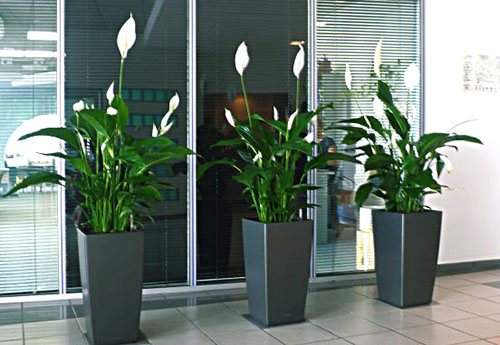

Yellowness on the leaves of a recently healthy green bush appears quickly and can be a sign of a variety of problems. Due to the similarity of symptoms, even experienced hobbyists rarely manage to immediately find the reason for this plant behavior. But it is impossible to hesitate, since the death of foliage entails a general weakening of the spathiphyllum, and sometimes it can signal irreversible putrefactive processes on the roots.
Most often, the source of problems with spathiphyllum is in the care of the flower, or rather, in the lack of attention to the plant.
If the plant has bloomed for a long time and abundantly, yellowing leaves can mean fatigue of the bush, which has wasted all the strength and available nutrients. In this case, the foliage from the lower tiers first begins to experience a similar deficit, evenly changes color, and then withers.
Top dressing can help the plant, and if the yellowed spathiphyllum has not been transplanted for a long time, then transfer it to a new, looser pot with nutritious loose soil.


In the future, in order to avoid similar problems, you need to feed the plant twice a year and, if necessary, in the spring, transplant the bush into a pot in size.
Prophylaxis
The main prevention in cases when the leaves turn yellow in spathiphyllum:
- Competent care.
- Providing optimal conditions for favorable plant growth.
- As soon as buds begin to form, it is imperative to increase the dosage of dressings. You can use any complex mineral fertilizers that are rich in potassium, boron and phosphorus. The nitrogen content should be low.
An important point is the regulation of the irrigation regime. You can find out whether it is necessary to moisten the soil in the following ways:
- To open the ground in a flowerpot and check the condition of the soil at a depth.
- Plant the plant in a transparent pot. If there is no condensation, this is a signal for watering.
- Place a stick without bark to the entire depth of the flowerpot and remove after fifteen minutes. Thus, the moisture level will be visible.
- Place special beacons in the ground that change color when humidity changes at a certain height.
In order to avoid hypothermia of the roots in winter, care must be taken to avoid drafts. If the room is cool, it is recommended to place a foam plate or a piece of thick woolen cloth under the flowerpot. You can also use a cork hot plate.
Causes of yellowness of spathiphyllum
One of the most common problems that growers face when growing spathiphyllum is yellow leaves. There are several reasons why "female happiness" can turn yellow. Let's consider the main ones.
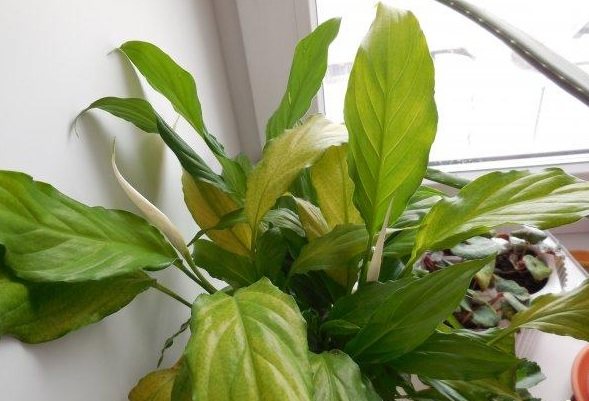

Often the main reason spathiphyllum turns yellow is a lack of moisture. If the irrigation regime is not followed, when the soil in the container is excessively dry, the spathiphyllum leaves dry and turn yellow. If the plant is located on a windowsill, then in winter, the warm and dry air from the battery can greatly dry it out. As a result of this, the tips of the leaves dry out in spathiphyllum, the plant stops blooming, slows down growth, withers and turns yellow. For the speedy recovery of the spathiphyllum, what to do first:
- 1It is definitely worth establishing a watering regime for the plant. It is advisable to do this gradually, especially if the flower has experienced drought for a long time. When the correct watering is resumed, the leaves of the flower soon turn green again and acquire the lost elasticity and density.
- 2Regularly moisten the plant by spraying with soft water. You can periodically wipe the leaves with a damp cloth. It will be useful to organize additional sources of moisture. For example, place containers of water or an aquarium next to a flower pot. This plant will feel great in the bathroom, one has only to provide it with natural light.
Another reason why the leaves of the plant "female happiness" may turn yellow is the presence of harmful insects. In this case, it is worth treating the flower with special preparations (for example, acaricides) as soon as possible, and disinfecting the soil with a fungicide. Or transplant the plant into fresh soil.
Too tight a pot can also cause the leaves on the spathiphyllum to turn yellow. When a flower is transplanted into a pot of the appropriate size, the problem disappears.
The tips of the leaves turned yellow
What to do in that situation if the tips of the leaves turn yellow:
- they must be cut off, while slightly capturing healthy tissue;
- the reason why this happened should be established;
- you need to take all the necessary measures: get rid of harmful factors, take care of the plant according to all the rules, and provide optimal conditions for keeping a green pet.
The basic steps will be the same as for the complete yellowing of the sheet plate.
What is yellowing?
Definition
Leaf yellowing is the process by which the tips or the entire surface of the leaf blades turn yellow, the turgor of the leaves is sharply reduced.
Appearance
Attention! If old leaves turn yellow and die off, this is a natural process of plant renewal.
In case of mass destruction, the tips or edges of the leaf plates, as well as the leaves as a whole, may turn yellow. Gradually, all the leaves turn yellow. The plant looks unhealthy and wilted.
We talked about why not only the leaves, but also other parts of the spathiphyllum turn yellow, as well as what to do in this case.
Photo
Next, you can see what the spathiphyllum leaves look like if they turn yellow.
Follow-up care at home
In order for a plant to delight the grower with its beautiful appearance for a long time, it is necessary to follow the basic rules:
- lighting should be scattered, there should be no direct sunlight on the plant;
- the air temperature in spring and summer should be in the range from plus 22 degrees to plus 24;
- in autumn and winter, the indicator should not decrease to plus 16 and below;
- in spring and summer, as well as during the period when the plant begins to bloom, it is necessary to water it abundantly;
- in winter and autumn, soil moistening is carried out moderately, excessive moistening and waterlogging of the substrate is not allowed;
- indoors, it is necessary to maintain a sufficiently high air humidity and spray the plant quite often;
- in the period from early spring to the end of summer and during flowering, the plant should be fed with a complex of mineral fertilizers with a low concentration.
If the leaves of spathiphyllum turn yellow, the reason for this is a gross violation of the conditions for growing the plant. Because of this, it can begin to wilt, and subsequently die. A very important factor is to establish the cause of this process. It is necessary to establish watering, follow the feeding schedule, protect the spathiphyllum from the bright sun and hypothermia.
Plant shrinking
Failure to comply with the watering regime leads not only to yellowing of the leaves of the flower, but also to their drying out.


Why do leaf tips dry? Watering the plant abundantly in the hope of getting rid of the yellowness of the leaves, a novice florist can only aggravate the situation. Excess moisture causes the leaves of the flower to dry out. The plant very poorly tolerates sharp changes between frequent and abundant watering and its complete and long absence.
In spathiphyllum, the tips of the leaves also dry out due to a lack of moisture. Be sure to water the plant only with soft water at room temperature.
Flowers can dry out due to unsuitable soil for them. By actively treating the flower with a chemical against pests, as well as not following the instructions, you can spoil the substrate. As a result: spathiphyllum dropped its leaves and began to dry out. A lack of nutrients in the soil can lead to the same deplorable state of the flower. It is necessary to transplant the plant into another soil enriched with useful substances. When transplanting, the tips of the leaves can also turn yellow and dry. However, this is a completely normal flower response to stress and does not require anxiety.


Symptom number 5. Spathiphyllum does not grow
Spathiphyllum does not increase the green mass: it does not release new leaves, does not give growth.
Reason # 1. Big pot
Remember that at first the spathiphyllum builds up the root system, and then begins to deal with the leaves. Therefore, if you transplanted the plant into a pot that is too large, you will have to wait for the root system to grow and entangle a clod of earth. Only after this will the growth of green mass begin.
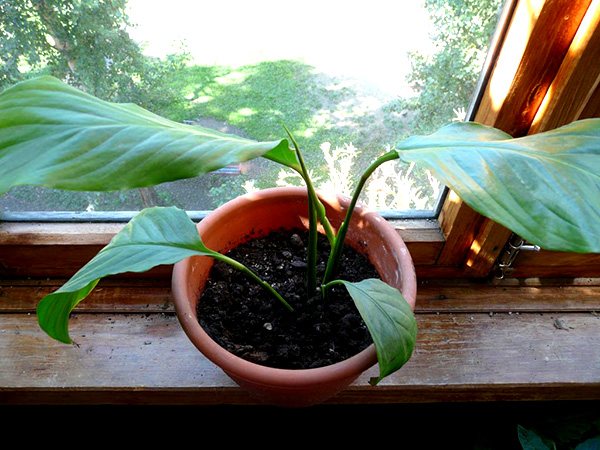

Such a pot is too large for a young spathiphyllum. I need a transplant!
What to do?
If you don't want to wait several months, you will have to transplant the spathiphyllum into a tighter pot - 1-2 cm larger in diameter than the root system.
Reason # 2. Inappropriate lighting
Spathiphyllum can inhibit growth with too intense or, conversely, poor lighting.
What to do? Move the spathiphyllum to a well-lit place without direct sunlight.
Brown spots on the leaves of spathiphyllum: why did they appear and how to cure the flower?
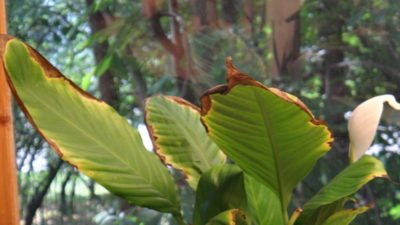

Spathiphyllum is called “female happiness” in another way. According to legend, the goddess of love Astarte, when she got married, gave this beautiful flower the power that brings happiness to every woman and girl who will believe in him.
In this article, it will be described in detail what kind of plant it is and how it looks in a healthy state, as well as, in fact, why dark spots of brown and black appear on the flower and what to do about it?
Popular varieties
Spathiphyllum is not only an ornamental plant, but also useful:
- able to clean the air of the room from the presence of toxic substances in it, such as: carbon monoxide, xylene, formaldehyde, trichlorethylene, benzene
- increases the humidity of the air, releasing into it substances that prevent the development of mold fungi.
Almost fifty varieties of Women's happiness are known to flower growers today, of which the most often found on window sills and in winter gardens:
Profusely blooming


It is a low bush. It has creamy flowers with a pleasant delicate aroma. The cover is much larger than the cob. It begins to bloom in March and ends in October. It was this feature that became the reason for such a name.
Wallis
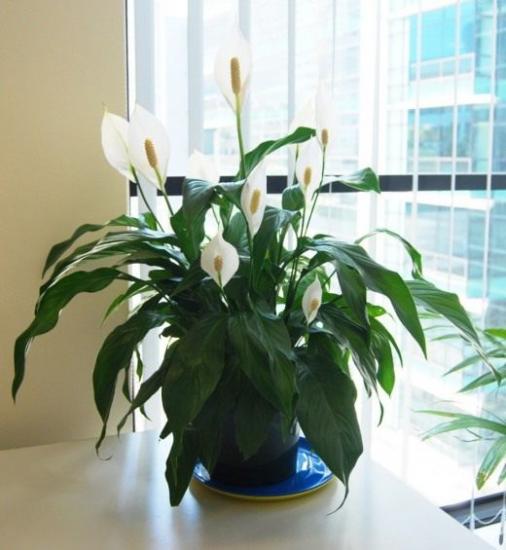

It is smaller in comparison with the richly flowering representative of this family. The flowers have narrow, elongated, pointed veils.
Canniferous


A snow-white blanket of a flower envelops an ear of yellow-green color. The leaves are large, their color is saturated, reminiscent of cannes. Has a pronounced aroma.
Charming
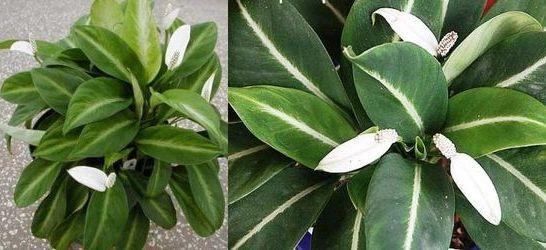

The plant has large, elongated leaves. The bedspread is greenish-white and resembles a flag. What was the reason for the second name "flagolite". It blooms profusely.
Heliconial
Representatives of this variety reach a height of up to one hundred centimeters. Their platinum plates have wavy edges, a glossy sheen, and are dyed dark green. The ear is almost two times smaller than the oval cover.


The presented species were used as a basis for breeding hybrid species, among which there are giants and dwarfs. Hybrid varieties are hardy, bloom for a long time and profusely.
Suitable fertilizers
So that the leaves of the spathiphyllum do not turn yellow, you should feed the flower in time, alternating mineral preparations with organic matter. Women's happiness responds well to a light solution of fermented cow dung or bird droppings, one part of which is diluted in 30 parts of water. For spathiphyllum, organic-based ready-to-eat foods are sold, such as Magic Blend and Garden of Miracles. They must be entered following the instructions in the instructions.
Feminine happiness develops well thanks to Agricola. It is applied before flowering. During the flowering period Kemira Lux or Uniflor-Bud are used as top dressing.
Although the flower Women's happiness does not require enhanced care, it is still not immune from diseases and injuries, so you need to cherish and surround it with care. After all, only a healthy plant can please with good flowering.
We offer a video about the causes of yellowing of leaves in spathiphyllum:
Why is this happening
The most common reason why spathiphyllum leaves turn black is a lack of proper care. In most cases, blackness indicates root damage. If the tips of the leaves are blackened in spathiphyllum, most likely the flower is being watered incorrectly, and the problem may also be in the wrong substrate.
Excess moisture
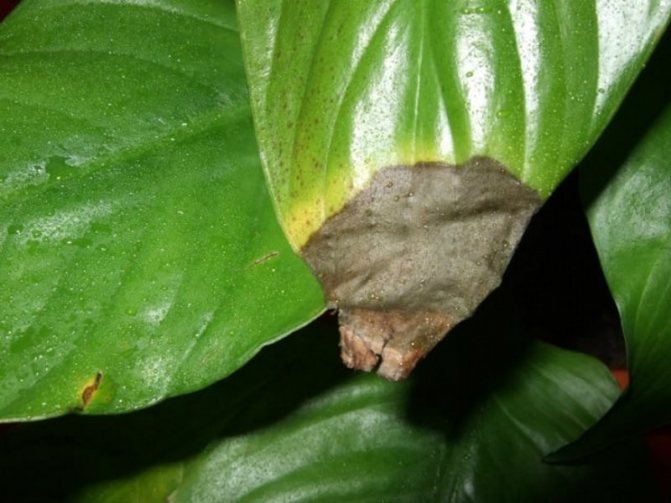

Women's happiness needs regular watering. It is desirable that the soil is kept moist, but at the same time, moisture stagnation should be avoided. When the root system is constantly in wet soil, it begins to rot. This is evidenced by the blackening of most of the leaf. Black edging appears on the inflorescence.
In the summer, the spathiphyllum flower should be watered abundantly once every 3-4 days. In winter, the plant prefers moderate watering, once a week is enough. The flower is watered when the top layer of the substrate dries up.
In spathiphyllum, the leaves turn black in case of infection with fungal infections, which primarily affect the root system. Their development is facilitated by moist soil and low air temperatures. Weeping, loose blackness appears on the infected parts of the plant, sometimes together with the manifestation of brown spots or specks.
Hypothermia
Another reason that the tips of the leaves of Feminine happiness dry out may be that the flower is freezing. Spathiphyllum is a thermophilic plant. It does not tolerate drafts and sudden temperature changes, as can be seen from sagging foliage and darkening of inflorescences. With light freezing, the flower will recover, only black tips will remain. If the plant is frozen when it was wet, it may die.
The roots can freeze if spathiphyllum is watered with cold water in winter. In this case, decay of the root system will begin, blackening of the foliage and dried tips of the leaves will begin to appear. Therefore, the water used for irrigation must be at room temperature.
You also need to monitor the air temperature in the room with the flower. In the summer season, it should correspond to 20-29 degrees. In winter - at least 15.
Since Women's happiness is a tropical plant, it needs high humidity. Large leaves are involved in the process of gas exchange, as a result of which a lot of moisture evaporates, which must be compensated. Therefore, the plant needs to ensure not only proper watering, but also spraying with soft, well-settled water at room temperature.
The procedure for spraying and washing Women's Happiness should be carried out throughout the year. In the summer season, it helps to clean the plant of dust and saturate it with moisture, in winter it maintains the humidity of the air at the required level. In addition, it is also pest prevention.
Often the result of the leaves of spathiphyllum turning black may be an excess of fertilizer. Their shortage also adversely affects the flower. When overfeeding, the root system is not able to cope with the excess amount of nutrients, which often leads to rotting, which causes blackening of the upper parts of the plant.
In the case of overfeeding, you will need to transplant into a new substrate, while cutting off rotten and damaged roots, and other parts of the spathiphyllum. The transplanted plant is fed as usual.
Fertilizers are applied twice a month by foliar method. Female happiness reacts well to organic matter, therefore it is recommended to alternate it with mineral fertilizers. It is important to use the drugs according to the instructions and in no case increase the dosage. In the winter season, spathiphyllum is at rest, so you should stop feeding it.
You do not need to fertilize the flower immediately after purchase, as usually in flower shops the plant is planted in soil saturated with nutrients.
The black color of various plant organs is certainly associated with a deterioration in the health of the spathiphyllum. Outwardly, blackness looks different.
- The tips of the leaves dry up and turn black, and a large area of brown appears along the edges. Over time, the places become dry, brittle. The foliage withers and falls off. If it does not fall, then the appearance of the plant still loses its decorative effect. This is "dry" blackness.
- There is also a "sluggish" or weeping blackening. Black leaves become wet, soft, slippery, and have lost their density.Often this phenomenon has an extensive distribution, perhaps fungal spores and mold appear over the affected area.
Reference! In spathiphyllum, the tips of the leaves, the entire plate, roots, and inflorescences may turn black. Depending on the cause, the area of the damaged area can grow quite quickly.
What does it threaten with?
Such spots worsen the appearance of the spathiphyllum and affect its general health, therefore, they are a signal that the plant is not properly cared for or it is affected by diseases, this can:
- disrupt the growth of the flower;
- postpone flowering;
- lead to complete destruction.
Treatment may vary depending on the type and location of the stains.
Slight drying of the tips
The reason for this damage to the leaves is too dry air in the apartment.
Measures to eliminate excessive flower dryness:
- spray at least twice a day;
- put a pot with a plant in a pallet with wet expanded clay;
- put spathiphyllum next to any container with water.
Extensive tip lesions
At the same time, a small yellow border is visible between the healthy and affected parts of the leaf. Large black spots are caused by overflow.
Measures to eliminate the defeat of the tips in Spathiphyllum:


observe a uniform watering regime: carry it out when the soil in the pot has dried up to one third of its height;- do not allow the soil to completely dry out and further too abundant watering.
As a rule, in most cases, it is precisely the abuse of watering the soil that is the cause of this disease. That is, the owners often forget to water the plant altogether, and when the soil is completely dry, they begin to abundantly and intensively fill it with water.
The edges and the middle of the sheet plate turn black and dry
There is also a narrow yellow border around the black area. The reason is the development of root rot as a result of too much prolonged watering.
Measures to eliminate blackening and yellowing of the middle of the leaf plate of the plant:
- Remove the plant from the container, rinse the roots until they are completely free from the ground (not under running water!).
- Cut off the rotten parts of the roots with a knife, sprinkle the slices with activated charcoal, dry.
- Completely replace the soil in the pot by adding activated carbon, transplant spathiphyllum without watering.
- Two days later, after the soil has dried, pour the flower with settled, slightly warm water. Add Kornevin to the water.
Dark specks with a yellow border in the middle
The reason is hypothermia of the roots, if they were poured with cold water in the evening, and at night the temperature in the apartment dropped or the pot with the plant stood in a draft.
Measures to remove black spots from a flower:
- remove the flower in a warm place;
- water only with warm water;
- spray with Epin (stress drug).
Large lesions without a border
The reason is that too much fertilizer has been applied. Usually, such spots appear very quickly after adding fertilizers: fertilized in the evening - in the morning the flower got sick.
Measures to eliminate excessive fertilization in the soil of Spathiphyllum:
- Rinse the roots in clean water (not under running water!).
- Completely change the potting soil.
The appearance of yellowness
- The first reason for yellowing of spathiphyllum leaves may be chlorosis (this is a disease that occurs due to a lack of iron in the soil). In this case, the veins remain green, and the leaves themselves turn yellow and may fall off.
To prevent chlorosis in a plant, you need:
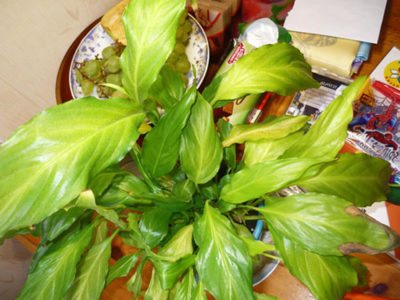

change the soil to a lighter one, since too dense retains moisture, which increases the alkaline component in it;- water the plant with the addition of a few grains of citric acid per 1 liter of water - this will increase the acidity of the soil.
To treat chlorosis, you should:
- spray the leaves with iron preparations (Ferovit, Antichlorosis);
- water the flower with the same preparations under the root for three days.
Measures to eliminate chlorosis in a flower:
- rearrange the flower in partial shade - to the window facing the north side;
if all the windows in the house face the sunny side, then you can simply move the spathiphyllum away from the window.
Foliage turns black at the edges, shrivels and withers
The reason is gommosis (this disease is caused by the bacteria Xanthomonas dieffenbachiae, which enter the spathiphyllum with water droplets). In addition, if dieffenbachia, anthurium or calla lilies grow next to the flower, the risk of infection with gommosis increases.
Measures to eliminate gommosis:
- diseased leaves are cut off and thrown away;
- healthy leaves are washed with running water and laundry soap;
- the leaves and the whole flower are treated with microbiological preparations Glyokladin, Alirin or Gamair;
- spray the flower over the leaves with a stress agent (Epin, HB-101).
Useful video
We offer an informative video about yellowing of Spathiphyllum leaves:
If you find an error, please select a piece of text and press Ctrl + Enter.
Spathiphyllum in the common people is called "female happiness." This evergreen tropical plant has amazing beauty. In the wild, it grows along the shores of reservoirs in South America and New Guinea.
The article will introduce you to the amazing spathiphyllum plant, the rules of care and reproduction, and will give you some useful tips.
The appearance of insect pests
The appearance of a flower can change not only due to poor care, but also due to the attack of pests.
Did you know? Spathiphyllum is popularly called
«
female happiness
»
... According to legend, the Greek goddess of love, Astrada, breathed into this flower a piece of happiness that overwhelmed her on her wedding day, so that every other girl could feel it, believing in the power of the flower.
Thrips
This is a small insect pest with a narrow elongated body and two porches, penetrating the leaf with the help of a tiny proboscis and sucking out all the juices from it. They arise due to a lack of moisture, stagnant air, excess nitrogen in the soil.
The signs of the pest are:
- small brown dots on leaf plates;
- young leaves and flowers are deformed and shrink;
- old leaves become stained or silvery and die off;
- openwork areas on sheet plates.
You can fight insects with folk or chemical means. But before proceeding with the treatment of the plant, it must be carefully examined, the affected foliage must be removed, and the diseased peduncles must be burned. With the help of a cotton swab, collect all the larvae, and rinse off adult insects with a warm shower. Then it is advisable to transplant the flower into a new soil and pot, and dispose of the old ones. Now you can carry out the treatment with one of the means in case not all pests were destroyed by the previous procedures.
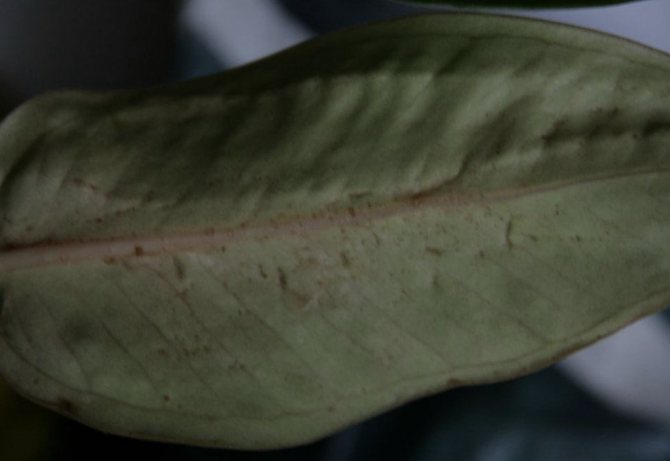

Folk recipes:
- Pour 50 grams of chopped dandelions with a liter of water and leave to infuse for 24 hours. Spray the plant with the solution.
- Pour 0.2 kg of chamomile flowers with a liter of boiling water and leave to brew for 10 hours. Strain and spray the flower several times a day for a week.
- 0.1 kg of crushed tobacco must be poured with a liter of boiling water and insisted for several days. Strain the infusion and process the whole plant.
Chemicals:
- Actellik. 1 ampoule of the product is diluted with a liter of water and used to process a flower. After the procedure, the spathiphyllum should be covered with a bag for 24 hours.
- Aktara. 4 g per 5 liters for spraying. Repeat after 7 days.
- Fitoverm. 2 ml for 200 ml of spray water. After the procedure, the flower must be covered with polyethylene for 24 hours.
Find out what to do if spathiphyllum isn't blooming.
Mealybug
Small (up to 10 mm in length) multi-legged insects with a rounded, oval or elongated body covered with a white waxy film. Their head from the body is practically inseparable.Lay white, translucent, rounded eggs. Appear due to:
- low temperature;
- high soil moisture;
- contaminated soil;
- untimely removal of dead parts of the flower.
The parasite usually hides on the inside of the leaf and covers its surface with sticky secretions. If the pest has just been detected, then it can be collected with a rag dipped in alcohol.
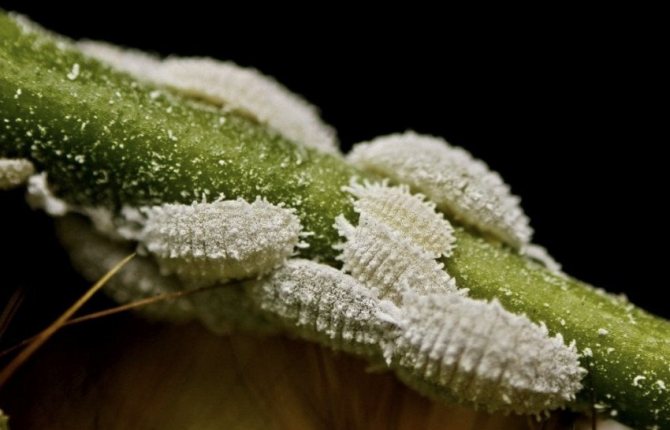

In case of severe damage, insecticides must be used:
- Aktara;
- Biotlin;
- "Calypso";
- "Confidant";
- "Confidor";
- Mospilan;
- Tanrek;
- Fitoverm.
Dilute them according to the instructions on the label, re-processing is carried out after 7-14 days.
Spider mite
Tiny insects, up to 1 mm long, red, yellow, orange. Due to their size, it is difficult to notice, moreover, they settle on the back side of the leaf plate.
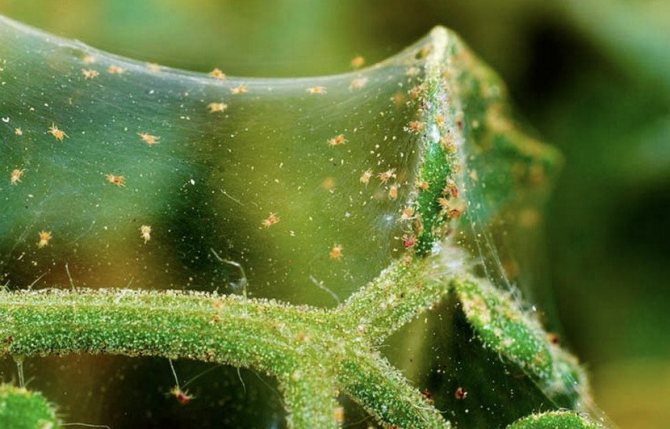

A striking sign of their appearance is a thin fine web. Ticks attack a flower when the air in the room is dry and hot.
In order to prevent the spread of the pest, the flowers should be regularly examined and, if a tick is found, wash it off with water and treat it with soapy water. If the case is started, then you need to resort to the help of insecticides ("Aktara").
Shield
Small oval insects are akin to scale insects. At a young age, it is very difficult to notice them, as they are small and move quickly. Adults are visible as brownish plaques. They usually settle on plants that are overfed with nitrogen, are in a cold or hot room, are watered incorrectly, and lack lighting. Their favorite place is the area between the petiole and the stem, as well as the bottom of the leaf plate. They can be noticed by the dark spots actively spreading over the flower, and by the twisted leaves.


When fighting a pest, the affected areas of the spathiphyllum are removed, and the rest are treated with a soap-tobacco solution with the addition of alcohol. Can be treated with nicotine sulfate (1 g per 1 L).
Important! If you are carrying out pest control with insecticides, you need to take precautions to avoid getting the product in your eyes or on your skin. It is also advisable to carry out the procedure in a non-residential, well-ventilated area.
As you can see, neglecting the rules for caring for spathiphyllum can cause a lot of additional trouble. And if the situation is neglected, then you can completely lose the flower. Therefore, it is easier to follow all the rules than to correct the consequences, and besides, they are not so complicated.
Watering
This exotic flower is very picky about water, so it should be soft and well-settled for watering. Cold water cannot be used for irrigation, otherwise it can get sick and completely shed the foliage. Watering is done only after the top layer of the soil has completely dried. If it is dry at a depth of one centimeter, then watering is necessary. After two hours, drain all excess water from the pan. If this is not done, the roots can rot. Water more often in summer than in winter.
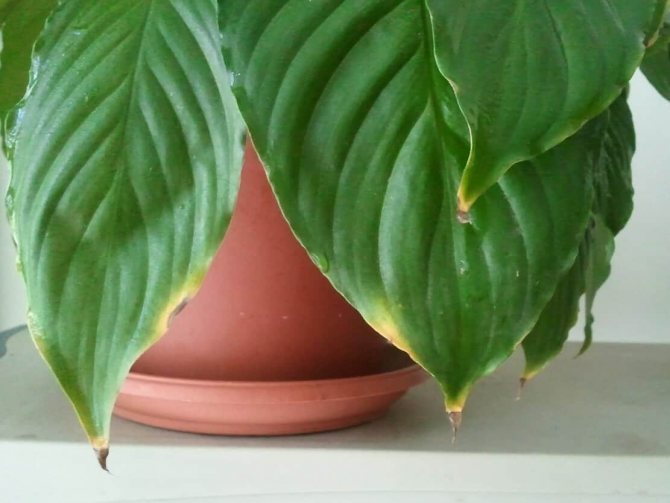

Photo
In the photo you can see the yellowed parts of the flower.
Forum, reviews of florists
Florists highly appreciate the decorative qualities of the flag leaf, but at the beginning of the journey, everyone makes mistakes. For many, the first acquired flower dies due to improper care. Experienced flower growers advise beginners to water indoor spathiphyllum only after the clod of earth has dried by a quarter or a slight loss of leaf turgor. With this method, pouring the pet will not work.
Another useful tip is not to philosophize with fertilizer. It is better to purchase a specialized composition for Aroids and strictly follow the instructions. This will prevent the roots from burning. Composing soil is a real art, leave it to the professionals. The finished primer will save you a lot of hassle. When the roots decay, the causative agent of the disease remains in the substrate, the soil must be changed. At the same time, all damaged parts are removed and processed.
Important! It is necessary not only to keep the root lobe in the fungicide solution, but also to remove all the spoiled leaves, spray the crown.
How to fix it?
As a rule, problems of this nature are associated with improperly organized care. Having figured out the possible causes of trouble, you should help the indoor exotic to restore its previous state.
When filling the soil
- Get the flower out of the pot, carefully examine and feel the root system.
- Cut dry, rotten roots.
- Disinfect the sections with ground cinnamon or crushed activated carbon.
- Treat the plant with a solution of the Maxim drug for prophylaxis.
- Transplant the flower into a new dry soil, also change the pot.
- Do not water immediately.
- A drainage layer is required.
- In the future, normalize the irrigation system.
- After moistening, after 15 minutes, drain excess liquid from the pan under the flowerpot.
Dry air


Normalize the temperature and humidity conditions in the room.- Use a humidifier regularly.
- Spray the leaves daily with a spray bottle.
- Perhaps place a flowerpot near the aquarium.
- Eliminate drafts and cold air on the flower.
- In winter, it is better to change your place of stay by removing it from the windowsill.
- Or cover heating appliances with a wet towel on a regular basis.
What can it lead to?
It is important to know that yellowing of parts of the spathiphyllum is followed by its rapid wilting and dying off, if urgent measures are not taken.
Over time, the plant will lose its rich green color., even young leaves and stems begin to tilt down, lose their elasticity (why can spathiphyllum drop leaves?). It is possible to stop the growth of spathiphyllum.
Symptom number 4. Withering leaves of spathiphyllum
If the leaves of the spathiphyllum are grafted and hung like rags, you need to immediately take action. This symptom indicates that the roots of the plant are not getting moisture.
Reason # 1. Overdrying an earthen coma
This is the most common reason. Spathiphyllum withers when the soil in the pot is dry and requires watering.


Such a spathiphyllum needs to be watered urgently!
What to do?
In order for the leaves of spathiphyllum to regain turgor, it is enough to water the plant. In some cases, if the soil is very dry or peat is used as a soil, simple watering from above may not give an effect. Then it is recommended to water the soil from above, as usual, and then immerse the pot with the plant in a pot (bucket, basin) with water for 15-20 minutes.
Reason # 2. Inhomogeneous ground
It so happens that after watering the leaves recover for a while, and then wither again. Despite the fact that the soil looks still moist! This means that the roots of the plant, located inside the pot, are in a dense, non-hygroscopic lump of soil that cannot be moistened with water during normal watering. Such a nuisance happens if, after the purchase, the spathiphyllum was transplanted into a new flower soil while preserving the store peat substrate on the roots. Such a substrate dries very quickly and turns into an impenetrable lump. At the same time, the new flower soil, into which the transplant was performed, retains water well and remains moist after watering. But water does not flow to the roots, since a dry lump of peat is retained on them.
What to do?
To prevent the leaves from withering, the store soil will have to be removed. To do this, rinse the roots in water and carefully remove the peat lumps from them. Then transplant the spathiphyllum into a homogeneous light soil.
Reason number 3. Decay of roots
Root decay occurs as a result of the bay. In this case, the leaves wither in the same way as when dry. The only difference is that when drying, it is enough to shed the earth for the roots to absorb moisture and the leaves to recover. When the roots decay, watering will no longer help; on the contrary, it will aggravate the situation: the leaves will fade with a vengeance.
A sign of root decay: the soil in the pot is constantly wet, despite the fact that watering has been carried out for a long time. Decaying roots do not absorb moisture from the soil, respectively, the plant is sick, does not receive water and nutrients. Unfortunately, root decay is an insidious disease that is not always quickly diagnosed. A novice florist, seeing that the spathiphyllum has wilted, will most likely begin to water it more and more. Until the flower is completely ruined!
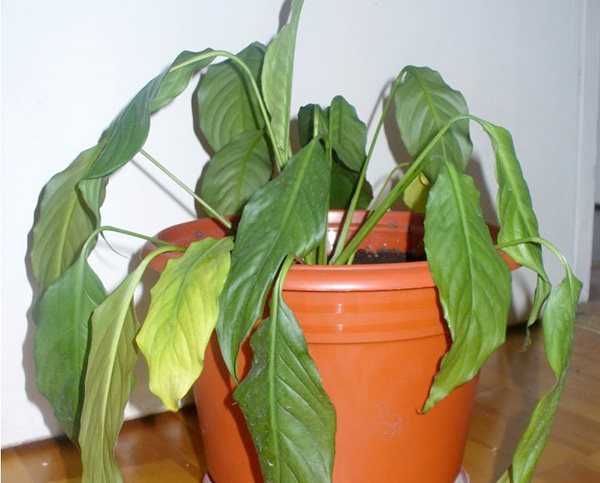

If after the gulf the soil was not dried and an impermeable swampy layer formed at the bottom of the pot, then the spathiphyllum is doomed to root rot
What to do?
If root decay is diagnosed, transplant the spathiphyllum into new soil with preliminary cutting of all decaying parts of the root. The transplant can be done as follows:
- Remove the spathiphyllum from the pot.
- Rinse the roots in water (in a bucket of water), gently freeing them from old soil.
- Cut all rotten roots with a clean knife to healthy tissue. Slices - dust with crushed activated charcoal or cinnamon.
- Leave the plant to dry for 2-3 hours.
- Plant the spathiphyllum in a new, light soil with activated charcoal (to prevent rotting of the slices). Be sure to add a good layer of drainage (2-3 cm at least) to the bottom of the pot to prevent water stagnation at the bottom of the roots. There should be drainage holes in the bottom of the pot (if there are few of them, make a few more with a nail or a hot screwdriver). No need to water right away! The parquet ground is initially damp, this is enough to support the life of the "amputated" roots.
- After 2-3 days, when the new soil dries out, pour the transplanted spathiphyllum with warm, settled (ideally boiled) water with the addition of Kornevin.
The soil
In order for the spathiphyllum to grow lush and bloom regularly, before transplanting, you need to take care of the correct composition of the soil. It should be loose, nutritious, oxygen and moisture permeable. The soil can be either bought in a specialized store or compiled independently by mixing 2 parts of turf, one part each of sand, peat and deciduous humus in one container. During transplantation, it is recommended to mix the soil with charcoal, which has antibacterial properties. There must be a small drainage layer at the bottom of the pot.
Effects
Important! If dark spots, blotches, black tips or roots are visible on a recently healthy plant, this is a signal for action.
One or more of the above causes these symptoms. If the matter is in improper care, then the situation is fixable.
It is worse when the exotic rots or an infectious disease develops. In this case, if the treatment does not arrive in time at the right time, then the room exot expects death. It is possible that in the later stages the whole flower will become black. In such a case, it is already pointless to do something.
Indoor flower pests
The defeat of the flower by insect pests is noticeable immediately - characteristic signs form on the leaves, the plant begins to wither, and in the absence of certain treatment it may die.
Spathiphyllum is a "delicacy" for many insect pests, but most often it is susceptible to the negative effects of aphids, spider mites, and mealybugs.
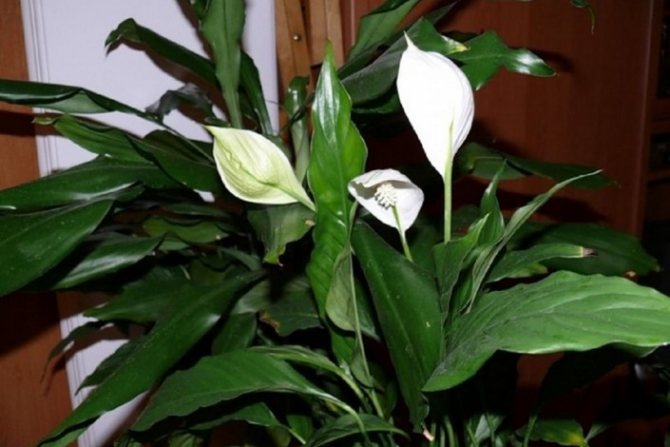

Spider mite
One of the most dangerous pests for indoor plants is the spider mite. Insect pests can be detected by the appearance of a characteristic thin cobweb on the lower leaves of the plant. Cobweb-covered parts of the leaf begin to wither over time.
It is necessary to use certain measures of influence on the spider mite immediately. If the pest "entangles" the entire plant with a web, then it will be almost impossible to cure it.
To destroy the spider mite, rinsing or spraying the flower with special solutions is used.Concentrated soap solution has good results. To prepare it, you need to grate half a piece of laundry soap on a fine grater, mix the resulting shavings with 1 glass of warm water, bring the composition to a homogeneous mass and thoroughly wash the affected plant structures with a ready-made soap solution.
Onion peel decoction is another effective remedy for spider mites. To prepare the composition, you need 500 ml. Boil water with 1 glass of onion husks. Insist the finished composition for a day and process the affected plant.
If spathiphyllum is strongly affected by a spider mite, then it is recommended to use insecticides to destroy the pest - Antimite, Akarin, Fitoverm, Neoron.
Another common pest of spathiphyllum is aphids. This tiny insect forms colonies that attack the leaves and stems of the plant. The insect feeds on the sap of the flower, large colonies of aphids can destroy the flower.
It is possible to determine the sabotage of aphids according to certain criteria:
Aphids are distinguished by active fertility, therefore, if even one or two insects are found, it is necessary to immediately take appropriate action. Aphid elimination is carried out with insecticidal preparations - Fitoverm, Aktara, Aktellik, Decis.


To completely destroy a harmful insect, several treatments are required (at least 2). In the process of performing the procedure, care must be taken that the chemical composition does not get on the soil. To do this, cover the pot with plastic wrap before spraying the plant.
Mealybug
The main reason for the appearance of a mealybug is high soil moisture. The pest "gnaws" the roots and leaves of the plant, provoking the development of the following signs - the leaves wither, dry, the plant brightens, the root system begins to rot. With extensive damage to the mealybug, spathiphyllum can die.
To eliminate insect pesting, the following means are used:
- decoction of citrus peels - in 1 glass of boiling water, brew the peel from 1-2 tangerines, thoroughly rinse all the structures of the flower with the resulting composition;
- alcohol solution - early pest damage can be eliminated by wiping the plant with an alcohol solution;
- insecticides - Aktellik, Aktofit, Aktara, Mospilan.
Sooty mushroom
The defeat of spathiphyllum with a fungal infection is very dangerous, if you do not start timely treatment, then the plant can die in the shortest possible time. Signs of damage are blackening of the upper leaves of the flower, darkening of the leaves and trunk.
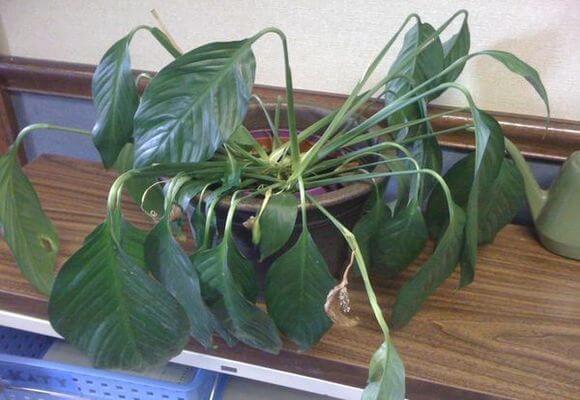

Measures to combat soot fungus are to treat the affected spathiphyllum. In the early stages of the lesion, you can use a concentrated soap solution, with abundant lesions - insecticides (Aktara, Horus, Decis, Sherpa).
The scabbard is a dangerous pest for spathiphyllum. The insect is difficult to see as its size is microscopic. The following signs can indicate the development of the disease - the appearance of small dark spots on the leaves and stem of the flower. The insect feeds on the juicy pulp of the plant, respectively, the affected structures of the flower begin to dry, wither, curl.
Read also: Why walnuts are useful for women: composition, reviews
At the initial stages of defeat, the fight against the scabbard is carried out using folk remedies. To do this, you can use a tobacco-soap solution or kerosene. Preparation of tobacco-soap solution - in 500 ml. boil water 2 tbsp. tablespoons of tobacco dust, cool the composition and add 1 tbsp. spoon of soap shavings.
Only insecticides - Fitoverm, Aktofit, Inta-Vir, Aktellik - can cope with a strong defeat of a harmful insect.
Temperature
They belong to heat-loving plants, therefore they react painfully to cold and sudden changes in temperature. First of all, the elasticity of their leaves disappears, after which they become wrinkled, lethargic, turn yellow and gradually dry out. Therefore, it is not recommended to keep them near an open window in cool weather, as well as near heating appliances.
The ideal temperature for keeping them is + 23 ° C. At temperatures below + 17 ° C or above + 30 ° C, he can get sick. Nevertheless, the room containing spathiphyllum should be regularly ventilated, but the container with it should be away from drafts.
Care rules
When buying a flower in a store specializing in the sale of indoor flowers, it must be transplanted, and this requires:
- prepare the ground thoroughly
- the soil mixture should consist of peat, sand, leafy soil and manure, taken in equal proportions. The mixture also contains ceramic chips and crushed birch charcoal.
- the pot in diameter should exceed the previous one by a couple of centimeters. It must be remembered that the flower needs to be transplanted once a year. The pot needs to be increased with each transplant.
- the hole designed to remove excess liquid must be covered with a shard with a bulge, and pebbles or expanded clay balls should be poured on top;
Prevention when the disease reappears
Sometimes flower growers, especially beginners, when faced with the yellowness of the leaves and their wilting, begin to "treat" flowers so actively that others, no less serious, are added to the existing problem.
This indoor flower has a rather weak root system; frequent transplantation is undesirable for it. When transplanting a plant into a new pot, it must be borne in mind that it may stop growing for some time, the leaves may suffer. It will get used to the new pot for a long time.
But even an old, cramped pot often becomes an obstacle to the development of a flower. With a lack of nutrition of the root system, this is reflected in the state of the leaves - they begin to dry and turn black. Choosing the correct size pot can fix this problem.
Various diseases and pests can also cause blackening of the leaf plate.
A change in leaf color can be a symptom of very dangerous plant diseases:
- Sooty fungus - affects the leaf plate, as evidenced by the blackening of the plant. Such a disease must certainly be eliminated urgently, since the respiration and photosynthesis of the plant are disrupted, it weakens and may die.
An effective way to get rid of sooty fungus is a soap solution, which thoroughly treats the affected surfaces.
- Scabbard - at the initial stage, it is barely distinguishable, the disease can be judged by the appearance of dark spots on the leaves of the spathiphyllum.
A very effective remedy against such a scourge is a soap-tobacco solution, which is mixed with several grams of kerosene or alcohol. The leaves are rubbed with this product for several days.
- Aphid - feeds on plant sap. If you do not get rid of this parasite, then the leaves begin to dry, curl and die off. Moreover, this infection spreads very quickly.
To get rid of insects, the flower is treated with a solution of nicotine sulfate, at the rate of 1 gram per liter of water.
- Blackened leaves are also observed with chlorosis or plant hommosis.
- Sometimes such defects of the leaf plate occur in an old plant that does not have the strength to further feed the stems and foliage.
In any case, if you find any unpleasant changes in the appearance of your pet, you should not despair. The first step is to make a correct diagnosis. After this, the necessary treatment will certainly bear fruit and female happiness will be able to delight others with her presence and beautiful flowers for a long time.
Of course, in order to avoid such problems, spathiphyllum should:
- Protect from the influence of external factors. Therefore, it is advised to take the flower outside for a couple of weeks, often do not ventilate, generally exclude the penetration of cold outside air.
- Maintain a temperature of 23 ° C, high humidity.
- Place the pot in a sunny place. However, avoid hitting the scorching rays of the sun on the foliage.
- Carry out regular watering, control the level of moisture in the flowerpot.
- Deal with the feeding system, if there is an excess, do not apply for some time, and if there is a shortage, then fertilize with complex components.
- Damaged black edges, cut off dark leaves.
Now, having learned why the spathiphyllum turns black, you need to draw the appropriate conclusions. Optimize care and maintenance parameters so that similar troubles do not arise in the future. Let this information be just in case, because "He who is informed is armed."

